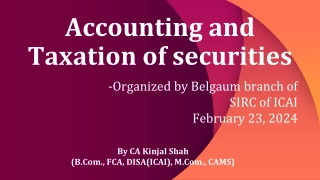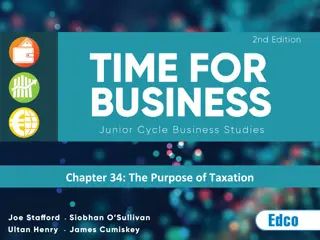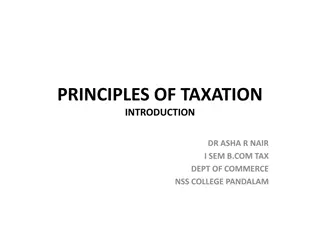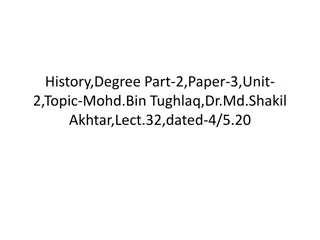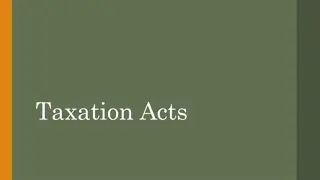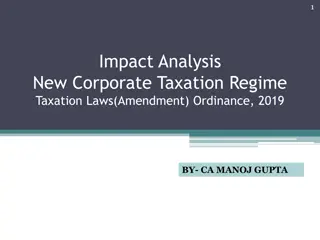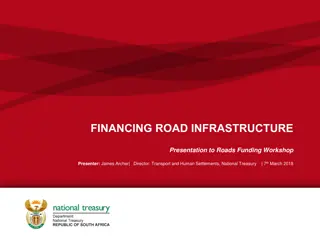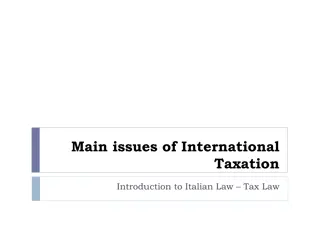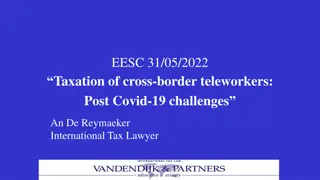Understanding Public Revenue and Taxation Fundamentals
Public revenue encompasses all income sources of the government, ranging from taxes to non-tax revenue. Taxes, the primary revenue source, are compulsory payments collected without direct benefits to taxpayers and play a crucial role in public finance and economic development. Non-tax revenue includes government income from sources other than taxation.
Download Presentation

Please find below an Image/Link to download the presentation.
The content on the website is provided AS IS for your information and personal use only. It may not be sold, licensed, or shared on other websites without obtaining consent from the author. Download presentation by click this link. If you encounter any issues during the download, it is possible that the publisher has removed the file from their server.
E N D
Presentation Transcript
Public Revenue The income of the government through all sources is called public income or public revenue. According to Dalton, Public Income has two senses wide and narrow. In its wider sense it includes all the incomes or receipts which a public authority may secure during any period of time. In its narrow sense, however, it includes only those sources of income of the public authority which are ordinarily known as revenue resources. The former is termed public receipts and the latter public revenue.
The Receipts of government of India are divided into revenue receipts and capital receipts. Revenue receipts consist of tax revenue and non-tax revenue.
Tax Revenue: Taxes are the first and foremost sources of public revenue. Taxes are compulsory payments to the government without expecting direct benefit or return by the taxpayer. Taxes collected by Government are used to provide common benefits to all mostly in form of public welfare services. Taxes do not guarantee any direct benefit for the person who pays the tax. It is not based on a direct quid pro quo principle.
The main characteristic features of a tax are as follows: (1) A tax is a compulsory payment to be paid by the citizens who are liable to pay it. Hence, the refusal to pay a tax is a punishable offense. (2) There is no direct, quid pro quo between the tax-payers and the public authority. In other words, the taxpayer cannot claim reciprocal benefits against the taxes paid. (3) A tax is levied to meet public spending incurred by the government in the general interest of the nation. It is a payment for an indirect service to be made by the government to the community as a whole.
(4) A tax is payable regularly and periodically as determined by the taxing authority. Taxes constitute a significant part of public revenue in modern public finance. Taxes have macro-economic effects. Taxation can affect the size and mode of consumption, the pattern of production and distribution of income and wealth. Progressive taxes can help in reducing inequalities of income and wealth by lowering the high-income group s disposable income. Taxes imply a forced saving in a developing economy. Thus, taxes constitute an important source of development finance.
There are two types of taxes, direct and indirect taxes. Direct taxes are imposed on income and wealth. Example .. Income tax, wealth tax etc Indirect taxes are imposed on purchase and sale of commodities. Example sales tax, excise duty custom duty, or GST NON-TAX REVENUE The revenue obtained by the government from sources other than the tax is called Non-Tax Revenue.
Public income received through the administration, commercial enterprises, gifts, and grants is the source of non- tax revenues of the government. Nontax revenue includes (i) Administrative revenue (ii) Profit from state enterprises (iii) Gifts and grants
Administrative Revenues: Under public administration, public authorities can raise some funds in the form of fees, fines and penalties, and special assessments. Fees: Fees are charged by the government or public authorities for rendering a service to the beneficiaries. Eg. Court fees, passport fees, licence fees, import licence fee, liquor permit fee, etc. Fees are to be paid by those who receive some special advantages.
Generally the amount of the fee depends upon the cost of services rendered. Fines and Penalties: Fines and penalties are levied and collected from offenders of laws as punishment. Special Assessments: Sometimes when the government undertakes certain types of public improvements such as construction of roads, provision of drainage, street lighting etc., it may confer a special benefit to those possessing properties nearby.
As a result, values of rents of these properties may rise. The government, therefore, may impose some special levy to recover a part of the expenses so incurred. Such special assessment is levied generally in proportion to the increase in the value of the properties involved. In this respect, it differs from a tax. In India, these special assessments are referred to as betterment levy. Betterment levy is imposed on land when its value is enhanced by the construction of social overhead capital such as roads, drainage, street- lighting, etc. by the public authority in an area.
Profits of State Enterprise: Profits of state undertakings also are an important source of revenue.For instance, the central government runs railways. Surplus from railway earnings can be normally contributed to the revenue budget of the central budget. Likewise, profits from the state transport corporation and other public undertakings can be important sources of revenue for the budgets of state governments. Similarly, other commercial undertakings in the public sector such as Bokaro Steel Plant, State Trading Corporation etc. can make profits to support the central budget.
Earnings from state enterprises depend upon the prices charged by them for their goods and services and the surplus derived therefrom. Thus, the pricing policy of state undertakings should be self-supporting and reasonably profit-oriented. Again, prices are charged with an element of quid pro quo i.e., directly in proportion to the benefits conferred by the services rendered. A price is a form of revenue derived by the government by selling goods and services of public enterprises. Thus, price is the revenue obtained from business activity undertaken by the public authorities. Many public enterprises like postal services run on cost-to-cost basis. The prices are charged just to cover the cost of rendering such services.
Gifts and Grants: When grants are made by one country s government to another country s government it is called foreign aid. Usually poor countries receive such aid from developed countries, which may be in the form of military aid, economic aid, food aid, technological aid, and so on. Deficit financing Borrowing
Objectives of Taxation: The primary purpose of taxation is to raise revenue to meet huge public expenditure. Most governmental activities must be financed by taxation. But it is not the only goal. In other words, taxation policy has some non-revenue objectives. Some of the objectives are 1. To raise revenue to meet expenditure 2. Reduce inequality of income 3. Eliminate absolute poverty 4. Economic development and full employment
5. Promoting saving and investment 6. Price stability 7. Control of imbalance of payments Principles or Canons of Taxation: By canons of taxation we simply mean the characteristics or qualities which a good tax system should possess. Adam Smith laid down the following canons of taxation:
Canon of Equality: The canon of equality or equity implies that the burden of taxation must be distributed equally or equitably in relation to the ability of the tax payers. Equity or social justice demands that the rich people should bear a heavier burden of tax and the poor a lesser burden. Hence, a tax system should contain progressive tax rates based on the tax-payer s ability to pay and sacrifice.
Canon of Certainty: Taxation must have an element of certainty. According to Adam Smith, the tax which each individual is bound to pay ought to be certain and not arbitrary. The time of payment, the manner of payment, the amount to be paid ought to be clear and plain to the contributor and to every other person. The certainty aspects of taxation are: 1. Certainty of effective incidence i.e., who shall bear the tax burden.
2. Certainty of liability as to how much shall be the tax amount payable in a particular period. This the tax payers as well as the exchequer should unambiguously know. 3. Certainty of revenue i.e., the government should be certain about the estimated collection of revenue from a given tax levied. Canon of Economy: This principle suggests that the cost of collecting a tax should not be exorbitant but be the minimum. Extravagant tax collection machinery is not justified.
Owing to the complex and ever-changing nature of taxation laws in India, government has to maintain elaborate tax collection machinery with a large staff of highly trained personnel involving high administrative costs and inordinate delay in assessment and collection of tax. Canon of Convenience: According to this canon, tax should be collected in a convenient manner from the tax payers. For example, it is convenient to pay a tax when it is deducted at source from the salaried classes at the time of paying salaries.
To these four canons, economists like Bastable have added a few more which are as under: Canon of Elasticity: Taxation should be elastic in nature in the sense that more revenue is automatically fetched when income of the people rises. This means that taxation must have built-in flexibility. Canon of Productivity: This implies that a tax must yield sufficient revenue and not adversely affect production in the economy.
Canon of Simplicity: This norm suggests that tax rates and tax systems ought to be simple and comprehensible and not to be complex and beyond the understanding of the layman. This is what is rarely found in the Indian tax structure. Canon of Diversity: Canon of diversity implies that there should be a multiple tax system of diverse nature rather than having a single tax system. In the former case, the tax payer will not be burdened with a high incidence of tax in the aggregate.
Canon of Expediency: This suggests that a tax should be determined on the ground of its economic, social and political expediency. For instance, a tax on agricultural income lacks social, political or administrative expediency in India and that is why the government of India had to discontinue it.
Direct Taxes: Direct taxes are levied on a person s or a firm s income or wealth and indirect taxes on spending on goods and services. Thus, direct taxes are paid directly by the person or firm on whom the assessment is made. Direct taxes cannot be legally evaded but in direct taxes can be avoided because people can reduce their purchases of the taxed goods and services. Direct taxes are mainly collected by the central government.
Examples of direct taxation include income tax, corporation tax (on companies profits), capital gains tax (a tax on the profits of sales of certain assets), wealth tax (which is a tax on ownership of property or wealth) and a capital transfer tax (a tax on gifts to replace death duties). Merits of Direct Taxes 1. Equity There is social justice in the allocation of tax burden in case of direct taxes as they are based on the principle of ability to pay. Persons in a similar economic situation are taxed at the same
rate. Persons with different economic standing are taxed at a different rate. Hence, there is both horizontal and vertical equity under direct taxation. Progressive direct taxation can reduce income inequalities and bring about adequate social & economic justice. 2. Certainty As far as direct taxes are concerned, the tax payer is certain as to how much he is expected to pay, as the tax rates are decided in advance. The Government can also estimate the tax revenue from direct taxes with a fair accuracy. Accordingly, the Government can make adjustments in its income and expenditure.
3. Relatively Elastic The direct taxes are relatively elastic. With an increase in income and wealth of individuals and companies, the yield from direct taxes will also increase. Elasticity also implies that the government's revenue can be increased by raising the rates of taxation. An increase in tax rates would increase the tax revenue. 4. Creates Public Consciousness They have educative value. In the case of direct taxes, the taxpayers are made to feel directly the burden of taxes and
hence take keen interest in how public funds are spent. The taxpayers are likely to be more aware about their rights and responsibilities as citizens of the state. 5. Economical Direct taxes are generally economical to collect. For instances, in the case of personal income tax, the tax can be deducted at source from the income or salaries of the individuals. Therefore, the government does not have to spend much in tax collection as far as personal income tax is concerned.
6. Anti-inflationary The direct taxes can help to control inflation. During inflationary periods, the government may increase the tax rate. With an increase in tax rate, the consumption demand may decline, which in turn may reduce inflation. Disadvantages / Demerits of Direct Taxes 1. Tax Evasion In India, there is good amount of tax evasion. The tax evasion is due to High tax rates, Documentation and formalities, Poor and corrupt tax administration.
It is easier for the businessmen to evade direct taxes. They invariable suppress correct information about their incomes by manipulating their accounts and evade tax on it. In less developed countries like India, due to high rate of progressive tax evasion & avoidance are extensive and led to rise in black money. 2. Arbitrary Rates The direct taxes tend to be arbitrary. Critics point out that there cannot be any objective basis for determining tax rates of direct taxes. Also, the exemption limits in the case of
personal income tax, wealth tax, etc., are determined in an arbitrary manner. A precise degree of progression in taxation is also difficult to achieve. Therefore direct taxes may not always fulfill the canon of equity. 3. Inconvenient Direct taxes are inconvenient in the sense that they involve several procedures and formalities in filing of returns. For most people payment of direct tax is not only inconvenient, it is psychological painful also. When people are required to pay a sizeable part of their income as a tax to the state, they feel
very much hurt and their propensity to evade tax remains high. Further every one who is required to pay a direct tax has to furnish appropriate evidence in support of the statement of his income & wealth & for this he has to maintain his accounts in proper form. Direct tax is considered inconvenient by some people because they have to make few lump sum payments to the governments, whereas their income receipts are distributed over the whole year. 4. Narrow Coverage In India, there is a narrow coverage of direct taxes. It is estimated that only three percent of the population pay
personal income tax. Due to low coverage, the government does not get enough funds for public expenditure. Estate duty & wealth tax are equally narrow based and thus revenue proceeds from these taxes are invariably small. 5. Affects Capital Formation The direct taxes can affect savings and investment. Due to taxes, the net income of the people gets reduced. This in turn reduces savings. Reduction in savings results in low investment. The low investment affects capital formation in the country.
6. Effect on Willingness and Ability to Work Highly progressive direct taxes reduce people's ability and willingness to work and save. This in turn may have a negative impact on investment and productive capacity in the economy. If tax burden is high, people's consumption level gets adversely affected and this has an impact on their ability to work and save. High taxes also discourage people from working harder in order to earn and save more. 7. Sectoral Imbalance In India, there is Sectoral imbalance as far as direct taxes are
concerned. Certain sectors like the corporate sector is heavily taxed, whereas, the agriculture sector is 100% tax free. Even the large rich farmers are exempted from payment of personal income tax. Indirect Taxes An indirect tax is one in which the burden can be shifted to others. The tax payer is not the tax bearer. The impact and incidence of indirect taxes are on different persons. An indirect tax is levied on and collected from a person who manages to pass it on to some other person or persons on
whom the real burden of tax falls. For e.g. commodity taxes or sales tax, excise duty, custom duties, etc. are indirect taxes Advantages / Merits of Indirect Taxes 1. Convenient Indirect taxes are imposed on production, sale and movements of goods and services. These are imposed on manufacturers, sellers and traders, but their burden may be shifted to consumers of goods and services who are the final
taxpayers. Such taxes, in the form of higher prices, are paid only on purchase of a commodity or the enjoyment of a service. So taxpayers do not feel the burden of these taxes. Besides, money burden of indirect taxes is not completely felt since the tax amount is actually hidden in the price of the commodity bought. They are also convenient because generally they are paid in small amounts and at intervals and are not in one lump sum. They are convenient from the point of view of the government also, since the tax amount is collected generally as a lump sum from manufacturers or traders.
2. Difficult to evade Indirect taxes have in built safeguards against tax evasion. The indirect taxes are paid by customers, and the sellers have to collect it and remit it to the Government. In the case of many products, the selling price is inclusive of indirect taxes. Therefore, the customer has no option to evade the indirect taxes. 3. Wide Coverage Unlike direct taxes, the indirect taxes have a wide coverage. Majority of the products or services are subject to indirect taxes. The consumers or users of such products and services have to pay them.
4. Elastic Some of the indirect taxes are elastic in nature. When government feels it necessary to increase its revenues, it increases these taxes. In times of prosperity indirect taxes produce huge revenues to the government. 5. Universality Indirect taxes are paid by all classes of people and so they are broad based. Poor people may be out of the net of the income tax, but they pay indirect taxes while buying goods.
6. Influence on Pattern of Production By imposing taxes on certain commodities or sectors, the government can achieve better allocation of resources. For e.g. By Imposing taxes on luxury goods and making them more expensive, government can divert resources from these sectors to sector producing necessary goods. 7. May not affect motivation to work and save The indirect taxes may not affect the motivation to work and to save. Since, most of the indirect taxes are not progressive in nature, individuals may not mind to pay them. In other words, indirect taxes are generally regressive in nature.
Therefore, individuals would not be demotivated to work and to save, which may increase investment. 8. Social Welfare The indirect taxes promote social welfare. The amount collected by way of taxes is utilized by the government for social welfare activities, including education, health and family welfare. Secondly, very high taxes are imposed on the consumption of harmful products such as alcoholic products, tobacco products, and such other products. So it is not only to check their consumption but also enables the state to collect substantial revenue in this manner.
9. Flexibility and Buoyancy The indirect taxes are more flexible and buoyant. Flexibility is the ability of the tax system to generate proportionately higher tax revenue with a change in tax base, and buoyancy is a wider concept, as it involves the ability of the tax system to generate proportionately higher tax revenue with a change in tax base, as well as tax rates.
Disadvantages / Demerits of Indirect Taxes 1. High Cost of Collection Indirect tax fails to satisfy the principle of economy. The government has to set up elaborate machinery to administer indirect taxes. Therefore, cost of tax collection per unit of revenue raised is generally higher in the case of most of the indirect taxes. 2. Increase income inequalities Generally, the indirect taxes are regressive in nature. The rich and the poor have to pay the same rate of indirect taxes on
certain commodities of mass consumption. This may further increase income disparities among the rich and the poor. 3. Affects Consumption Indirect taxes affects consumption of certain products. For instance, a high rate of duty on certain products such as consumer durables may restrict the use of such products. Consumers belonging to the middle class group may delay their purchases, or they may not buy at all. The reduction in consumption affects the investment and production activities, which in turn hampers economic growth.
4. Lack of Social Consciousness Indirect taxes do not create any social consciousness as the taxpayers do not feel the burden of the taxes they pay. 5. Uncertainty Indirect taxes are often rather uncertain. Taxes on commodities with elastic demand are particularly uncertain, since quantity demanded will greatly affect as prices go up due to the imposition of tax. In fact a higher rate of tax on a particular commodity may not bring in more revenue.
6. Inflationary The indirect taxes are inflationary in nature. The tax charged on goods and services increase their prices. Therefore, to reduce inflationary pressure, the government may reduce the tax rates, especially, on essential items. 7. Possibility of tax evasion There is a possibility of evasion of indirect taxes as some customers may not pay indirect taxes with the support of sellers. For instance, individuals may purchase items without a bill, and therefore, may not pay Sales tax or VAT (Value Added Tax), or may obtain the services without a bill, and therefore, may evade the service tax.
Tax Base A tax base is the total amount if assets or income that can be taxed by a taxing authority, usually by the government. It is used to calculate tax liabilities. This can be of different forms, including income or property. If the minimum amount is lowered, the tax base automatically increases. If the minimum amount is raised, the tax base gets narrowed, it means the number of people required to pay tax is increased or decreased. The governments , specially in developing economies widens the tax base. It means bring more people into tax net or makig them legally liable to pay taxes.
Tax Rates The tax rate is the ratio (usually expressed as a percentage) at which a business or person is taxed. Amount of tax = tax base x tax rate A tax base measures the capacity to bear the tax burden and the tax rate distributes the burden according to equity. The tax rates are of following types. 1. Proportional taxations 2. Progressive taxation 3. Regressive taxation 4. Digressive taxation
Proportional tax A proportional tax is a tax imposed so that the tax rate is fixed, with no change as the taxable base amount increases or decreases. The amount of the tax is in proportion to the amount subject to taxation. Proportional describes a distribution effect on income or expenditure, referring to the way the rate remains consistent (does not progress from low to high or high to low as income or consumption changes), where the marginal tax rate is equal to the average tax rate.
Progressive Taxes: Taxes in which the rate of tax increases are called progressive taxes. Thus, in a progressive tax, the amount of tax paid will increase at a higher rate than the increase in tax base or income, for the taxation amount is the product of multiplying the base by the rate and both these increase in a progressive tax. Thus, a progressive tax extracts an increasing proportion of rising income.




